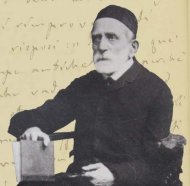Ercole Ferrario was among the most significant figures of Gallaratese culture in the second half of the 19th century.
He was the first honorary inspector of archaeological excavations from 1878 to 1890. A role that allowed him to foster relationships with the great scholars of the time. Such as the well-known Theodor Mommsen whom he guided during his visit to the church of San Pietro. Was a pioneer in the cataloging and protection of local National Monuments. In 1896 he encouraged a group of young enthusiasts to create a circle of scholars and men of letters interested in the study, conservation, history and promotion of the area, forming what became the association of Studi Patri, of which he was honorary president.
Ferrario was born in 1816 in Samarate, was a mayor of Samarate in the united Italy, later president of the councils in the municipalities of Gallarate and Cardano al Campo, and was described as a patriot for having taken a direct part in the The Five Days of Milan insurrection and then holding a moderate position during the Risorgimento. He completed his first studies at the Legnano middle school and the Porta Nuova high school in Milan. Then he went on to enroll in the main faculty of medicine and surgery at the University of Pavia in 1834. Ferrario was a doctor by profession, first at the military hospital of Sant’Ambrogio in Milan, then a general practitioner in Busto Arsizio.
The question of the “morality” of the peasants
He left numerous writings on medical, social-hygienic and agronomic subjects. As well as biographies of doctors from the past who were appreciated by his contemporaries. In the last part of his life, he dedicated himself to the question of the “morality” of the peasants. It was one of the crucial points of the crisis in the northern part of Milan and its surroundings. This is along with the other problems of a Lombardy affected by a sudden economic, social and cultural transformation.
After studying the problem, he promoted the idea of the need for projects aimed at improving the peasants’ standard of living. He pointed out that the matter of hygiene was intertwined with moral, intellectual and economic matters, and insisting that the material and moral misery of the peasants could and had to be alleviated by the upper classes, who were called upon to play a leading role in promoting progress for the peasantry.
As a consequence, came the consideration of the need for teaching reforms in the countryside. In fact, many of his publications concentrated on the search for easy-to-understand language in order to smooth out the conflict between peasants and the upper classes. As it was an obstacle to economic progress and a source of social tension.
The most interesting publications included the experimentation of new means for communicating with an audience that was not made up exclusively of professionals. It consisted of both technical manuals but also a country novel and a collection of proverbs relating to agriculture.
Activity as excavation inspector
A hundred or so notes and writings concerning his activity as excavation inspector were also found. They were gathered in two diaries, 12 files, for a total of 286 pages which he himself called Chaos. This chronologically ordered collection of thoughts, maxims, impressions, anecdotes on politics, religion, customs and local history, reports of the inspections of archaeological sites accompanied by drawings of the materials found between 1865 and 1866, constitutes an inexhaustible source for reconstructing his work and illustrating the stages of every aspect of Varese archaeology.
There are other excerpts of particular interest dated back to 1865 which lead us to reflect on how books can be a source of inspiration. Although they are not sufficient on their own if not accompanied by example, and even when man persists in not wanting to learn from history, there will always be books that act like witnesses. Like friends we refer to in every moment of our lives:
Books can be compared to the stars
«Books can be compared to the stars, in fact some – though they are very few – like the sun, illuminate, warm and fertilize. Others, like the moon, scatter a little light but not enough to make objects clearly distinguishable and are therefore often the cause of errors and misunderstandings. Others, like the stars, scatter so scarce and languid a light that it is of almost no use, with which they make themselves very imperfectly seen and give us but a glimpse of larger objects. And finally others – and these are the most numerous – are like racing cars, shooting stars that dazzle our eyes for an instant and rather than lead us, send us astray.»
«A book can radiate light all around itself, but it will do little to dispel the darkness of error especially in the countryside, if it is not assisted by practical example, by the effective application of what it teaches. If books could amend the vices of mankind, mankind would have long since been free and virtuous.»
Ferrario died in Gallarate in 1897 and is still highly appreciated as can be seen by the countless books written about his work. Upon his death, Gallarate dedicated a stretch of the ring road to him and Samarate gave his name to a street in the center. While Milan dedicated a street to him by inscribing “philanthropist who accomplished pious work” on the toponymic plaque.
As his legacy, he leaves his avant-garde spirit. His understanding even back in those times, that the future development of a people is correlated to the protection of its history. Photo www.artevarese.com

Return to Gallarate